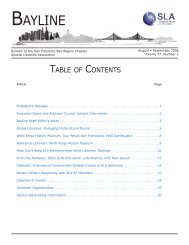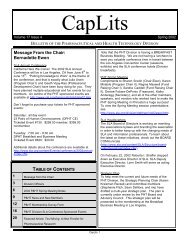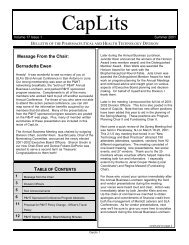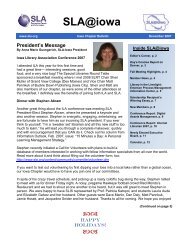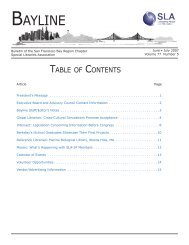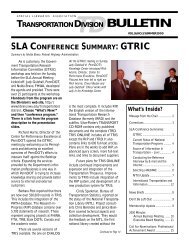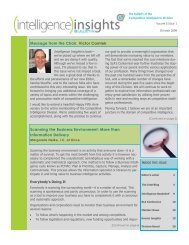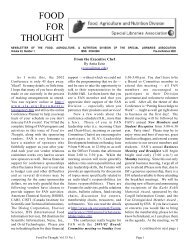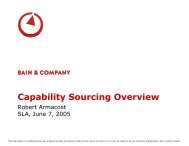Silent Spring - units.sla.org
Silent Spring - units.sla.org
Silent Spring - units.sla.org
You also want an ePaper? Increase the reach of your titles
YUMPU automatically turns print PDFs into web optimized ePapers that Google loves.
Dr. Diana Post<br />
President, Rachel Carson Council<br />
www.RachelCarsonCouncil.<strong>org</strong><br />
rccouncil@aol.com<br />
(301)593-7507<br />
June 17, 2009<br />
Assistance provided by<br />
Michael K. Liddel , PhD<br />
1
Introduction<br />
Rachel Carson is considered on the 20 th Century’s greatest<br />
Americans and the fountainhead of modern<br />
environmentalism.<br />
She had a deep respect for both nature and science<br />
Her Fourth book, <strong>Silent</strong> <strong>Spring</strong>, brought issues pertaining<br />
to chemical pesticide toxicity fron the level of scientific<br />
society discussions to citizens’ dinner tables and President<br />
Kennedy's press conference.<br />
After 1962, the year of <strong>Silent</strong> <strong>Spring</strong>’s publication, the<br />
problems of technology became difficult for the<br />
government to ignore.<br />
Rachel Carson gave voice to those scientists and thinkers<br />
whose concerns about pesticides’ dangers especially to<br />
wildlife had existed since before the end of World War II.<br />
2
Overview: Rachel Carson’s Impact on Science<br />
Presidents Science Advisory Council (PSAC)<br />
Kennedy’s Expert Panel to Review <strong>Silent</strong> <strong>Spring</strong><br />
Rachel Carson’s Impact on Ecology Education<br />
Increasing concern about chemical contamination<br />
Rachel Carson’s Vision of Pesticide Regulation & the EPA.<br />
Risk Assessment & Multiple Pesticide Exposures<br />
The Rachel Carson Council<br />
DDT<br />
Common misconceptions<br />
Toxicity to humans<br />
3
President’s Science Advisory Council<br />
Established by President Kennedy to evaluate <strong>Silent</strong> <strong>Spring</strong><br />
The PSAC recommended that persistent pesticides be<br />
phased out.<br />
Carson concurred, as she stated in her June 4, 1963<br />
testimony<br />
“Statement of Rachel Carson Before the Subcommittee on<br />
Re<strong>org</strong>anization and International Organizations of the Committee<br />
on Governmental Operations. Environmental Hazards: Control of<br />
Pesticides and Other Chemical Poisons -- June 4, 1963<br />
4
<strong>Silent</strong> <strong>Spring</strong> and Ecology Education<br />
<strong>Silent</strong> <strong>Spring</strong> increased concern for pesticide<br />
contamination<br />
Documented by Peterson and Peterson (2000) Ecology,<br />
according to <strong>Silent</strong> <strong>Spring</strong>’s Vision of Progress in And No<br />
Birds Sing (Waddell ed).<br />
<strong>Silent</strong> <strong>Spring</strong> is now required reading in many<br />
university courses in ecology and biology.<br />
5
<strong>Silent</strong> <strong>Spring</strong> and Ecology Education<br />
In their essay “Ecology according to <strong>Silent</strong> <strong>Spring</strong>’s<br />
Vision of Progress”, the Peterson’s documented the<br />
increasing focus on chemical contamination in three<br />
successive editions of a widely used ecology text<br />
during the 1950 to 1970 period. They also found that<br />
two college level ecology texts published in the mid<br />
1990s emphasized ecological means of pest<br />
management as being more scientific than other<br />
means.<br />
6
<strong>Silent</strong> <strong>Spring</strong> and Ecology<br />
<strong>Silent</strong> <strong>Spring</strong> added a new<br />
perspective:<br />
Human beings are a part of<br />
nature and what we do to nature,<br />
we do to ourselves<br />
Rachel Carson’ general purpose<br />
in writing <strong>Silent</strong> <strong>Spring</strong> was to<br />
highlight this perspective<br />
This view anticipates the 2005<br />
Millennium Ecosystem<br />
Assessment. Jane Lubchenko<br />
(2008)<br />
7
The Millennium Ecosystem Assessment<br />
Published in 2005, it catalogued into 4 areas the<br />
essential services provided by functioning ecosystems:<br />
1) Supporting<br />
Soil formation, nutrient recycling<br />
2) Provisioning<br />
Food, water, fiber<br />
3) Regulating<br />
Climate control and pest control<br />
4) Cultural<br />
Aesthetic , spiritual<br />
8
Rachel Carson’s Vision of Pesticide<br />
Regulation and the EPA<br />
“If we are ever to find our way out of the present<br />
deplorable situation, we must remain vigilant, we must<br />
continue to challenge and to question , we must insist<br />
that the burden of proof is on those who would use<br />
these chemicals to prove their procedures are safe.”<br />
-Rachel Carson : “A New Chapter to <strong>Silent</strong> <strong>Spring</strong>”<br />
- Bulletin of the Garden Club of America, May 1963<br />
9
EPA’s Conditions for Pesticide Regulation<br />
EPA’s Pesticide regulation system does not require that<br />
pesticides be proven safe.<br />
Pesticides are registered by EPA under two risk/benefit<br />
decision-making standards. One for human health, the<br />
other for the environment.<br />
Registered pesticides can never be considered “Safe”’.<br />
Companies have been prosecuted and fined for calling their<br />
pesticides safe.<br />
For more see RCC “Issues and Insights”, Oct 2004 and 40CFR:162.10 (a)(5)(ix))<br />
10
EPA Pesticide Regulation<br />
Ecological & wildlife risks are balanced against the<br />
benefits of using the pesticides<br />
The EPA’s evaluation standard for wildlife is that under<br />
the registered conditions of use, the pesticide use will<br />
not pose an unreasonable risk to the environment or<br />
that it represents no unreasonable risk of harm to<br />
wildlife (Merenda 1998)<br />
11
Pesticides’ Impact on Wildlife<br />
“…the EPA’s ecological risk assessments often show<br />
that legal applications of certain pesticides will almost<br />
certainly kill non-target species that happen to be<br />
nesting, feeding, flying or swimming in and around<br />
treated farm fields. In the real world of pesticide<br />
regulation, birds, fish, and bees are expendable.”<br />
Dr. Chuck Benbrook, “Prevention, Not Profit, Should<br />
Drive Pest Management.” 2008 Rachel Carson Memorial<br />
Lecture (Pesticide News Dec 2008)<br />
12
Costs of wildlife fatalities due to<br />
pesticides<br />
72 million bird deaths annually with an estimated cost to<br />
society of $2.1 billion<br />
14 million fish deaths annually with and estimated cost to<br />
society of $56 million<br />
Estimated cost to society from damage to pollinating<br />
insects and insects that are natural predators of pests is<br />
$700 million annually.<br />
Dr. David Pimentel, 1998, RCC’s Wildlife Pesticides and<br />
People Conference<br />
13
Pesticides and Human Health<br />
EPA’s standard for human health risks from registered<br />
pesticides, provides a reasonable certainty of no harm,<br />
especially for the very young. (Merenda, 1998)<br />
Unfortunately, the Agency does not always carry out this<br />
mandate<br />
14
Public Perception of EPA’s Risk Assessment<br />
RCC believes that today the public is largely<br />
unaware of EPA’s risk/benefit standards.<br />
We believe that those who care about protecting wildlife,<br />
would find them unacceptable.<br />
Rachel’s recommendation, that those promoting<br />
the chemicals prove that their procedures are safe,<br />
is closer to how the FDA approves drugs than the<br />
way the EPA registers pesticides.<br />
Perhaps her influence can still have the power to protect<br />
vulnerable wildlife or at least the public can be informed of<br />
the hazards.<br />
15
Multiple Pesticide Exposures<br />
“In water and soil, and in our own bodies,<br />
these chemicals are mingled with<br />
others…There are little understood<br />
interactions and summations of effect.”<br />
Rachel Carson, June 4, 1963 Congressional Testimony<br />
16
Multiple Pesticide Exposures<br />
The 1996 Food Quality Protection act calls for<br />
estimating aggregate and cumulative risks to human<br />
health from pesticides by EPA .<br />
Aggregate risk: Impact of multiple sources of a single<br />
pesticide active ingredient, such as chlorpyrifos.<br />
Cumulative risk: The impact of several active ingredients<br />
with the same mode of action such as<br />
<strong>org</strong>anophosphates, of which chlorpyrifos is an example.<br />
17
Multiple Pesticide Exposures<br />
Pesticide mixtures at environmentally realistic levels<br />
impact wildlife<br />
Pesticide Combinations have been associated with loss<br />
of olfactory sense in migratory fish (Tierney et al 2008)<br />
This leads to problems locating breeding areas, avoiding<br />
predation, finding food, etc.<br />
A pesticide synergist applied with a short-lived<br />
insecticide could remain active in underwater sediments<br />
and combine with a longer lived insecticide already<br />
existing in the sediment, enhancing the latter’s toxicity<br />
for aquatic <strong>org</strong>anisms (Weston 2006)<br />
18
Multiple Pesticide Exposures<br />
RCC’s Perspective:<br />
EPA needs to give greater consideration to pesticides<br />
mixtures’ impacts on humans, pets and wildlife. All risk<br />
assessments should include aggregate and cumulative<br />
assessments.<br />
In addition, assessments should be made for multiple<br />
exposures to chemical pesticides that may not have the<br />
same mode of action but have a common toxic endpoint<br />
such as cancer, liver damage, neurotoxicity, etc.<br />
19
The Rachel Carson Council (RCC)<br />
Rachel Carson Council, a 501(c)(3) non-profit<br />
<strong>org</strong>anization, is one of Rachel’s enduring legacies. It<br />
was founded a year after her death to continue the<br />
efforts started with <strong>Silent</strong> <strong>Spring</strong>.<br />
RCC researches pesticides’ impacts, low-risk pest<br />
management alternatives and fosters a sense of<br />
wonder and respect for nature as did Rachel Carson.<br />
20
Rachel Carson Council<br />
RCC’s searchable database<br />
of over 490 pesticide active<br />
ingredients, an update of<br />
the 1992 The Basic Guide to<br />
Pesticides, is being<br />
prepared for distribution.<br />
21
Rachel Carson & DDT :<br />
Common Misconceptions<br />
Rachel Carson did not initiate the call for banning DDT in<br />
<strong>Silent</strong> <strong>Spring</strong>.<br />
The PSAC recommended phasing out persistent pesticides,<br />
including DDT.<br />
Rachel concurred with this recommendation.<br />
DDT has never been banned worldwide<br />
It is still permitted to be used and still used for mosquito<br />
control<br />
Special permission to use DDT can be granted under the 2001<br />
Stockholm Convention<br />
The US has signed this treaty but it has not been ratified<br />
22
DDT Common Misconceptions<br />
According to some historians DDT protected crops from<br />
pests and saved millions of people from malaria, and its<br />
hazardous effects on wildlife and human health only<br />
became known to scientists after years of use. An example<br />
of unforeseen consequences?<br />
Professor Edmund Russell (2004, personal communication)<br />
“During World War II (DDT’s developers) anticipated and<br />
tested for, most of the problems that led to DDT being<br />
banned...” DDT was released to the public at the end of the<br />
war not because its developers failed to foresee problems; it<br />
was released because no government agency had authority<br />
after the war to restrict its sale or use.<br />
23
DDT Misconceptions: Unforeseen<br />
Consequences<br />
Government researchers knew that:<br />
DDT accumulated in the milk of lab mammals and passed into<br />
their offspring.<br />
DDT killed fish when sprayed at a wildlife refuge.<br />
DDT killed off the insect predators, that helped to control pest<br />
insects.<br />
“These concerns were taken seriously enough that the US<br />
banned the aerial spraying of DDT inside the US during the war.”<br />
After the war scientists advised industry to hold off the civilian<br />
market until they could develop a way to minimize its hazards,<br />
but the majority of chemical companies decided to sell DDT<br />
regardless.<br />
Edmund Russell (2004 personal communication)<br />
24
DDT Misconceptions: Unforeseen<br />
Consequences<br />
For further information see:<br />
“The Strange Career of DDT: Experts, Federal Capacity<br />
and Environmentalism in World War II.” Edmund<br />
Russell in Technology and Culture 40(1999) 770-796<br />
War and Nature: Fighting Humans and Insects with<br />
Chemicals. By Edmund Russell, 2001<br />
25
DDT Effects on Humans<br />
DDT can act on the nervous, reproductive, endocrine<br />
and immune systems, and on the liver. It has also been<br />
associated with cancer in humans.<br />
EPA generally does not require testing of pesticides for<br />
their effects on the immune system.<br />
26
DDT Effects on Humans<br />
Neurological Effects<br />
A birth cohort study of children of Mexican farm<br />
workers in California found prenatal exposure to DDT<br />
associated with neurodevelopment delays during early<br />
childhood (Eskenazi et al, 2006)<br />
Adverse effects of DDT in humans reported to poison<br />
control centers include “sensory<br />
disturbances…headache, dizziness, nausea, vomiting,<br />
incoordination, mental confusion, and [in more serious<br />
cases] seizures.” (Reigert & Roberts 1999)<br />
27
Effects on Birds and on Humans<br />
Neurological Effects<br />
by Implication<br />
DDT related changes in the robin brain are found to be<br />
significant and related to those structures associated with mating<br />
and song. “Given the magnitude of these changes in the brain<br />
and and the fact that environmental DDT exposure was restricted<br />
to early development, we conclude that both humans and wildlife<br />
that live in DDT contaminated environments may be at risk of<br />
neurological damage.” (Iwaniuk et al 2006)<br />
28
DDT Effects on Humans<br />
Reproductive Effects<br />
Using DDT in Africa against malaria mosquitoes might<br />
kill as many African babies as it could save due to low<br />
birth weight babies, and shortened lactation time for<br />
mothers. If DDT use became widespread, the lactation<br />
period could become 40% shorter (Rogan& Chen 2005 as found<br />
in Karaim 2005)<br />
29
DDT Effects on Humans<br />
Reproductive Effects<br />
A study of semen parameters in Mexico where DDT was<br />
used to control malaria found that exposure was related<br />
to impaired semen quality.<br />
Men with higher DDE levels had a lower percentage of motile<br />
sperm and greater percentage of sperm with tail defects.<br />
(Ayotte et al 2001)<br />
Impaired semen quality was associated with DDT<br />
exposure in young men living in malaria areas of<br />
Limpopo Provence, South Africa. (Aneck-Hahn 2006)<br />
30
DDT Effects on Humans<br />
Endocrine System<br />
The prevalence of diabetes mellitus (sugar diabetes) in<br />
people was found to be between 3 & 5 times higher<br />
depending on their blood serum concentrations of<br />
persistent <strong>org</strong>anic pollutants such as DDE (a breakdown<br />
product of DDT) (Lee et al 2002)<br />
When the sum of 6 persistent <strong>org</strong>anic pollutants are considered there<br />
is a 5-38 times increased likelihood of diabetes developing. (Lee et al<br />
2002)<br />
31
DDT Effects on Humans<br />
Immune System Effects<br />
“…chemotaxis and phagocytosis (immune protective<br />
mechanisms) were found to be markedly depressed in<br />
occupationally DDT-exposed workers. Additionally, the<br />
prevalence of infectious episodes was significantly<br />
higher in these workers than in a control population.”<br />
(Descotes 1988)<br />
32
Immune Effects on Fish<br />
DDT Effects<br />
A brief period of exposure to o,p’-DDE during early<br />
development of Chinook salmon was associated with a<br />
reduced ability for antibody production in the treated<br />
fish one year later. The authors concluded: “Such<br />
immunosuppression may increase susceptibility to<br />
disease.” DDT and DDE have been found to have<br />
estrogen and antiandrogen effects. Receptors for<br />
estrogen have been identified on immune system cells<br />
indicating that endocrine immune interaction can<br />
occur. (Milston et al 2003)<br />
33
DDT Effects: Breast Cancer<br />
A 2007 study (Cohn et al) in the US measured DDT<br />
blood levels in archived samples from women patients<br />
with breast cancer and discovered a significant link<br />
with increased concentrations of this pesticide<br />
Blood samples reflected DDT exposure of patients as<br />
young girls<br />
Highest levels of DDT during critical period of breast<br />
development were found to have a greater than 5 fold<br />
increased risk of developing Breast cancer later in life.<br />
This study calls attention to the increasing vulnerability to<br />
hazardous outcomes that can accompany exposure of<br />
developing individuals to toxic chemicals<br />
34
DDT and Liver Cancer<br />
A 2006 case-control study (McGlynn et al 2006) found<br />
high DDT blood levels to be associated with liver<br />
cancer in Chinese patients. Subjects with the highest<br />
DDT levels were 3.8 times more likely to develop liver<br />
cancer than those with the lowest levels.<br />
DDE a metabolite of DDT was not associated with this<br />
effect<br />
The authors concluded that DDT may be a risk factor for<br />
liver cancer and that the individual patient’s ability to<br />
metabolize DDT may be involved.<br />
35
Global Trends in Malaria<br />
In the 1950s the Global Malaria Eradication program<br />
using DDT was launched.<br />
In 1969 through the 1980s WHO focused on drug<br />
therapy against malaria.<br />
During the 1990s the malaria parasite developed<br />
resistance to the drug of choice, chloroquine, and<br />
deaths increased.<br />
In 2006 Dr. Kochi director of the WHO program<br />
supported the use of bed nets, combination drug<br />
therapy featuring artemisinin and DDT spraying of<br />
interior walls.<br />
36
Global Trends in Malaria Control<br />
A 2008 Report focused on Rwanda and Ethiopia<br />
showed greater then 50% reduction in malaria<br />
mortality nationwide in high burden countries.<br />
“Indoor spraying with DDT and other insecticides–<br />
used in Rwanda at the end of the study period, and<br />
before and during it in Ethiopia – did not appear to be<br />
a factor in the steep, sudden declines. “ (Brown 2008)<br />
37
Conclusions: Rachel & Science<br />
Rachel Carson had an influence on ecology and<br />
toxicology in various ways, including her legacy<br />
<strong>org</strong>anization RCC.<br />
Rachel believed that those who use chemical<br />
pesticides should be required to prove them safe – now<br />
pesticides are registered by the EPA under a<br />
risk/benefit standard and are not even allowed to be<br />
called “safe” by manufacturers or marketers.<br />
Exposure to pesticide mixtures, not single agents<br />
occurs in the real world, as Rachel Carson asserted.<br />
EPA needs to do more assessments of such risks<br />
38
Conclusions (continued)<br />
Based on research DDT has been associated with human<br />
health problems, including: Reduced sperm<br />
production, shorter lactation times, and increasing<br />
number of preterm births in women, learning<br />
disorders in children, immune system damage as<br />
well as primary liver cancer and breast cancer.<br />
In May of this year UNEP (United Nations Enviroment Program) and<br />
WHO (World Health Organization) announced new projects<br />
using sustainable alternatives to DDT such as mosquito<br />
repellant trees, fish that eat mosquito larvae and<br />
elimination of mosquito breeding sites. They aim to<br />
reduce the use of DDT worldwide by 30% in 2014.<br />
39
References<br />
Aneck-Hahn, NH et al (2006) “Impaired semen quality associated with environmental DDT exposure in young men living in a malaria area in<br />
the Limpopo Province, South Africa” Journal of Andrology, Dec 27 2006<br />
Ayotte, P., S Girous, E Dewailly, M Avila Hernandez, P Farias, R Danis, and C Diaz Villanueva. (2001) “ DDT Spraying for Malaria Control and<br />
Reproductive Function in Mexican Men.” Epidemiology 12(5)<br />
Brown, D (2008) “Anti-Malaria Efforts Yield New Success”. The Washington Post. Feb 1, 2008<br />
Cohn, M, MS Wolff, PM Cirillo,and RI Sholtz. (2007) DDT and Breast Cancer in Young Women: New Data on the significance of age at<br />
exposure. Environmental Health Perspectives 115:1406-1414<br />
Descotes J (1988) Immunotoxicology of Drugs and Chemicals, 2 nd updated edition, 1988, Elsevier<br />
Eskenazi, B et al (2006) “In utero Exposure to Dichlorodiphenyltrichloroethane (DDT), Dichlorodiphenyldichloroethylene (DDE) and<br />
Neurodevelopment among young Mexican American Children” Pediatrics 118(1):233-241<br />
Iwaniuk AN, DT Koperski, LK Smith, and DR Wylie (2006) “Effects of Environmental Exposure to DDT on the brain of a songbird: Changes<br />
in structures associated with mating and song.” Behavioral Brain Research July 4, 2006<br />
Lee DK et al (2002) “ A strong dose-response relation between serum concentrations of persistent <strong>org</strong>anic pollutants and diabetes. Results<br />
from the National Health Examination Survey 1999-2002” Diabetes Care 29: 1638-1644<br />
Lubchenko J (2008) “Rachel Carson’s Scientific and Ocean Legacies”, in Rachel Carson Legacy and Challenge, Sideris & Moore eds. 2008<br />
McGlynn, KA (2006) Serum concentrations of 1,1,1-Trichloro-2,2-bis(p-chlorophenyl)ethane (DDT) and 1,1,-Dichloro-2-2-bis(pchlorophenyl)ethylene(DDE)<br />
and Risk of Primary Liver Cancer,” Journal of the National Cancer Institute 98(14) 1005-1010<br />
Merenda J (1998) Presentation at the Wildlife, Pesticides and People Conference<br />
Milston RH, MS Fitzpatrick, AT Vella, S Clements, D Gundersen, G Feist, TL Crippen, J Leong, and CB Schreck. (2003) “Short-Term Exposure<br />
of Chinook Salmon (Oncoryhnchus tshawytscha) to o,p-DDE or DMSO during Early Life-History Stages Causes Long-Term Humoral<br />
Immunosuppression” Environmental Health Perspectives 11(13) October 2003<br />
Reigart JR and JR Roberts (1999) Recognition and Management of Pesticide Poisonings, Fifth Edition. Office of Pesticide Programs,<br />
Environmental Protection Agency<br />
Rogan & Chen (2005) from Reed Karim “Not so fast with the DDT: Rachel Carson’s Warnings Still Apply.” The American Scholar, 74(3),<br />
Summer 2005<br />
Tierney KB, Sampson JL, Ross PS, Sekela MA, and Kennedy CJ (2008) Salmon Olfaction is Impaired by an environmentally Realistic Pesticide<br />
Mixture. Environmental Science and Technology. 42:4996-5001<br />
Weston DP (2006) “Aquatic Effects of Aerial Spraying of Aerial Spraying for Mosquito Control over an Urban Area.” Environmental Science<br />
and Technology 40(18): 5817-5822<br />
40



